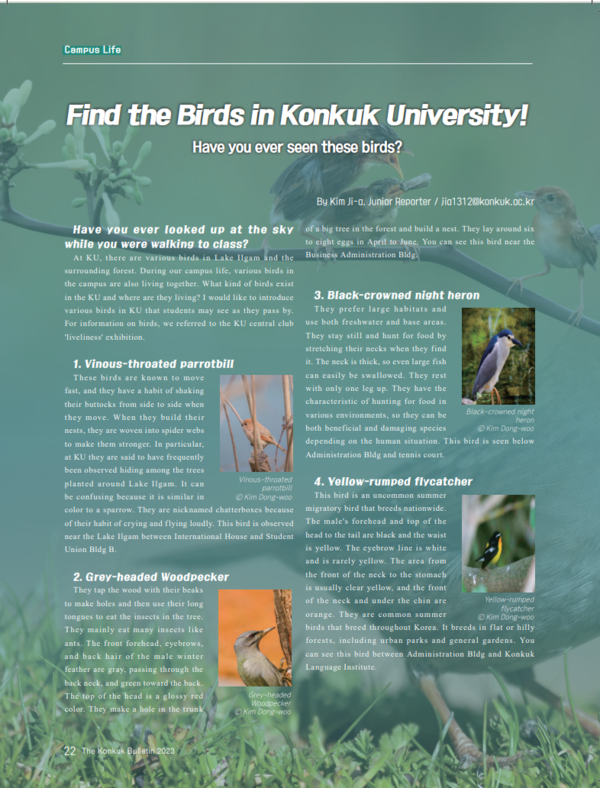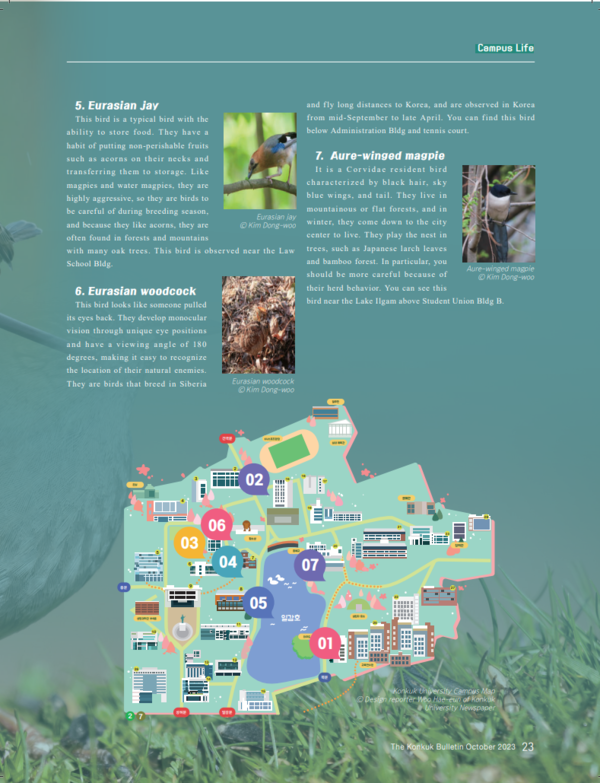Have you ever seen these birds?


Have you ever looked up at the sky while you were walking to class? At KU, there are various birds in Lake Ilgam and the surrounding forest. During our campus life, various birds in the campus are also living together. What kind of birds exist in the KU and where are they living? I would like to introduce various birds in KU that students may see as they pass by. For information on birds, we referred to the KU central club 'liveliness' exhibition.
1. Vinous-throated parrotbill These birds are known to move fast, and they have a habit of shaking their buttocks from side to side when they move. When they build their nests, they are woven into spider webs to make them stronger. In particular, at KU they are said to have frequently been observed hiding among the trees planted around Lake Ilgam. It can be confusing because it is similar in color to a sparrow. They are nicknamed chatterboxes because of their habit of crying and flying loudly. This bird is observed near the Lake Ilgam between International House and Student Union Bldg B.
2. Grey-headed Woodpecker They tap the wood with their beaks to make holes and then use their long tongues to eat the insects in the tree. They mainly eat many insects like ants. The front forehead, eyebrows, and back hair of the male winter feather are gray, passing through the back neck, and green toward the back. The top of the head is a glossy red color. They make a hole in the trunk of a big tree in the forest and build a nest. They lay around six to eight eggs in April to June. You can see this bird near the Business Administration Bldg.
3. Black-crowned night heron They prefer large habitats and use both freshwater and base areas. They stay still and hunt for food by stretching their necks when they find it. The neck is thick, so even large fish can easily be swallowed. They rest with only one leg up. They have the characteristic of hunting for food in various environments, so they can be both beneficial and damaging species depending on the human situation. This bird is seen below Administration Bldg and tennis court.
4. Yellow-rumped flycatcher This bird is an uncommon summer migratory bird that breeds nationwide. The male's forehead and top of the head to the tail are black and the waist is yellow. The eyebrow line is white and is rarely yellow. The area from the front of the neck to the stomach is usually clear yellow, and the front of the neck and under the chin are orange. They are common summer birds that breed throughout Korea. It breeds in flat or hilly forests, including urban parks and general gardens. You can see this bird between Administration Bldg and Konkuk Language Institute.
5. Eurasian jay This bird is a typical bird with the ability to store food. They have a habit of putting non-perishable fruits such as acorns on their necks and transferring them to storage. Like magpies and water magpies, they are highly aggressive, so they are birds to be careful of during breeding season, and because they like acorns, they are often found in forests and mountains with many oak trees. This bird is observed near the Law School Bldg.
6. Eurasian woodcock This bird looks like someone pulled its eyes back. They develop monocular vision through unique eye positions and have a viewing angle of 180 degrees, making it easy to recognize the location of their natural enemies. They are birds that breed in Siberia and fly long distances to Korea, and are observed in Korea from mid-September to late April. You can find this bird below Administration Bldg and tennis court
7. Aure-winged magpie It is a Cor v id ae resident bi rd characterized by black hair, sky blue wings, and tail. They live in mountainous or flat forests, and in winter, they come down to the city center to live. They play the nest in trees, such as Japanese larch leaves and bamboo forest. In particular, you should be more careful because of their herd behavior. You can see this bird near the Lake Ilgam above Student Union Bldg B.

